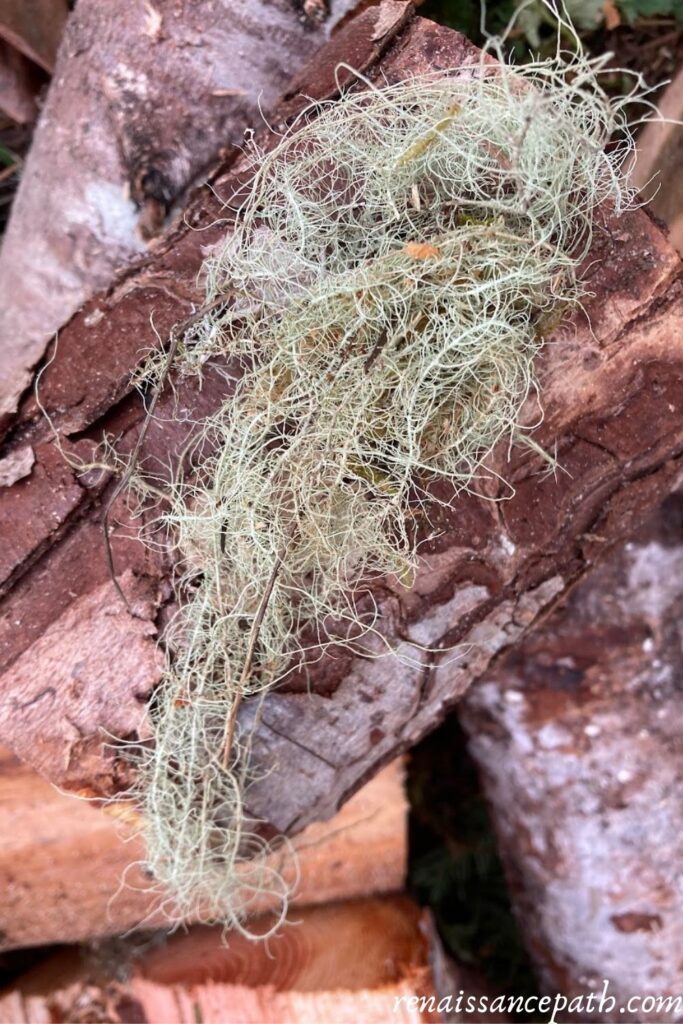
Some of the links on this page contain affiliate links. Renaissance Path is a participant in the Amazon Associates Program, an affiliate advertising program that provides a way for websites to earn advertising fees by linking to products. We only link to products we normally use and trust. When you purchase an item through the link we receive a small commission at no additional cost to you. This helps pay for the costs associated with running this blog. Your support is greatly appreciated. Thank You!
Old Mans Beard-Natures Antibiotic
Chances are you have seen Old Mans Beard growing in a forest near you, or even on a tree in your own back yard. Old Mans Beard is called Usnea. Usnea is natures antibiotic, or that’s what I like to call it. Usnea looks like a green or pale green hairy beard hanging from branches and trees.
A lot of people think Usnea looks very similar to Irish moss. Usnea is NOT considered a plant but a Lichen. Lichens are a combination of a fungus and algae living in a symbiotic relationship.
There are hundreds of Usnea species worldwide. And Usnea grows almost everywhere throughout the world. Usnea tends to grow on conifer trees like pine, hemlock, spruce, cedar, and fir. But it’s known to also be found on oak, walnut, apple, and hickory trees.
When I see Usnea I get really excited. I have experienced first hand the powers of Usnea. I have used it for infected gums and also used it for upper respiratory infections with great success.
What I like about Usnea is it’s been shown to be able to go into bacteria and shut off its ability to produce ATP, ATP is the bacteria energy system. This can help bacteria from being able to reproduce.
Usnea Herbal Actions
- Antibacterial
- Analgesic
- Anti-fugal
- Anti-mitotic
- Anti-parasitic
- Antitumor
- Anti-inflammatory
- Antiseptic
- Antiviral
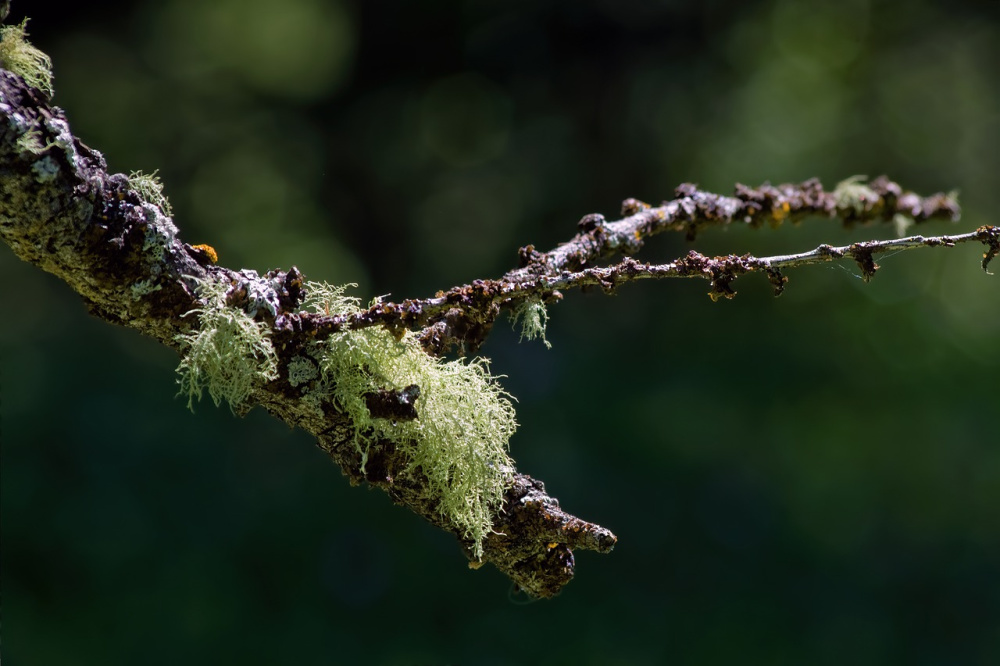
Bacteria Usnea is Active Against
Usnea has been shown to be active against primarily gram-positive bacteria. Both resistant bacteria strains and nonresistant strains.
Usnea has been shown in some in vitro studies to be active against some gram-negative bacteria like Helicobacter pylori, Proteus mirabillis, Yersinia, E. coli, and enterocolitica.
Gram-positive bacteria
Staphylococcus simulans
Streptococcus faecalis
Streptococcus mutans
Streptococcus pyogenes
Staphylococcus aureus
Enterococcus faecium
Enterococcus faecalis
Propionbacterium acnes
Mycobacterium tuberculosis
Listeria monocytogenes
Micrococcus viridans
Clostridium spp.
Corynebacterium diphtheriae
Bacteroides spp.
Bacillus megaterium
Bacillus subtillis
Studies have shown usnea to be effective against Streptococcus aka strep throat(1). Usnea also showed strong activity against m. tuberculosis (2).
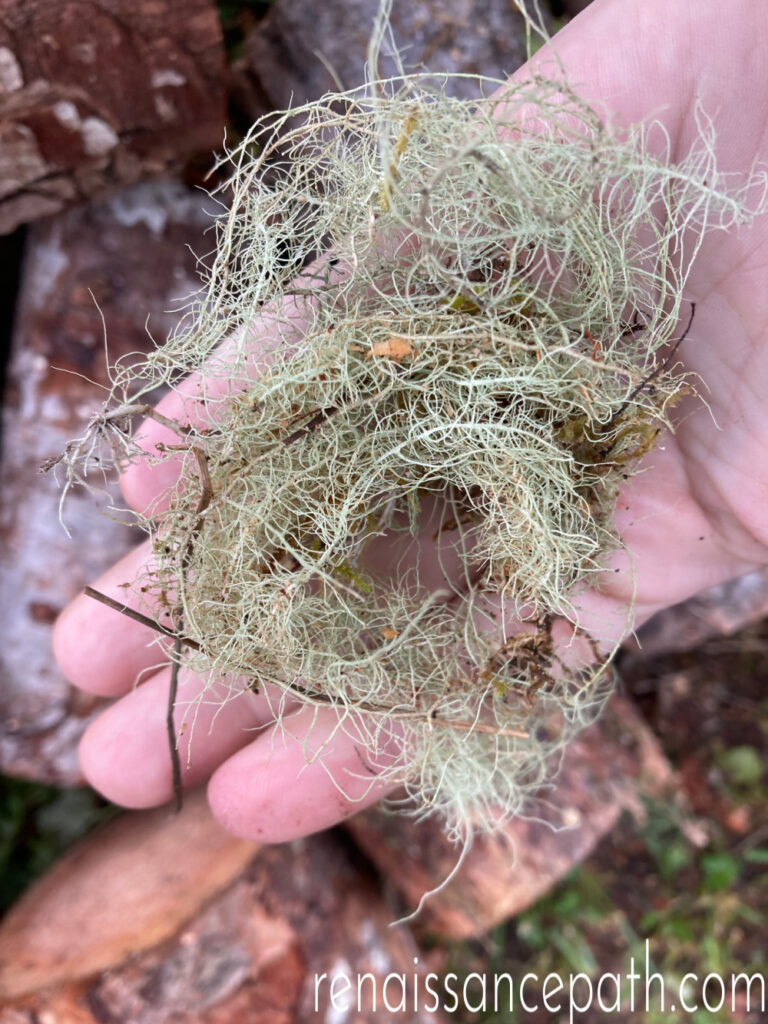
Medicinal Benefits of Usnea
In herbal medicine, Usnea is thought of as a natural antibiotic. It has pretty strong antibacterial properties. It’s mostly known and used for strep throat, sinus infections, bronchitis, viral and fungal infections as well as parasitic infections.
Usnea works by disrupting bacterial cell membrane function, discourages ATP formation and oxidative phosphorylation without impacting human cells.
Usnea contains Usnic acid. Usnic acid is a powerful antibacterial. Even though usnea is a strong antibacterial it doesn’t seem to kill all good bacteria as antibiotics can.
It is anti-inflammatory and this can help relieve pain. It has been shown to treat fevers. Usnea may help treat urinary infections, respiratory infections and even aid in weight loss.
Usnea seems to have strong activity of certain drug-resistant bacteria(3).
It also has anti-fungal properties and is effective against Candidiasis(4).
Some herbalists say usnea may be superior to Flagyl against Trichomonas, which is a parasite that causes cervical and uterine infections.
Usnea was shown to have anticancer properties(5).
Usnea has a constituent called Protolichesterinic Acid. This powerful chemical helps get inside the mitochondria of the fungus and cause death, this is why usnea is such a powerful anti-fungal making it good for athletes foot, ringworm, and candida(6).
Usnea has been shown to be active against a number of viruses: herpes simplex, polyomavirus, Epstein-Barr virus, Junin virus, and Tacaribe virus.
How to Identify Usnea
Usnea is fairly easy to identify. It is green to light green/grayish in color. It really does look like a long beard of hair. Another tell-tale sign you have found usnea is to take one strand and gently pull between two fingers and you will see it has some stretchy bounce to it like you’re pulling on a rubber band. In the middle of these little hairs is the elastic stretchy threads that are white.
Usnea tends to like old-growth forests. Although I have seen it in young forests.
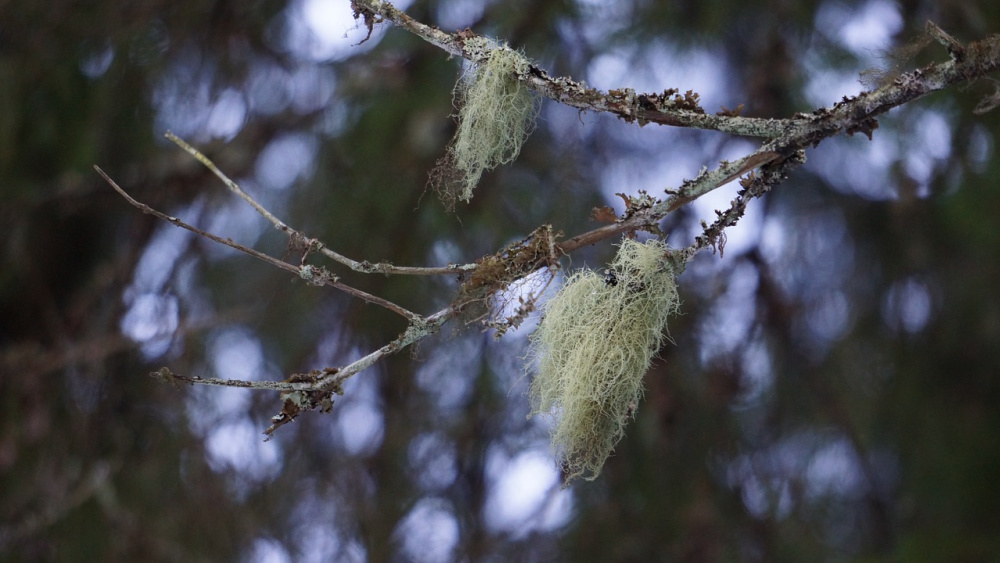
Harvesting Usnea
Usnea is often referred to as ‘the lungs of the forest”. Usnea is a lichen and lichens do not have roots or a protective surface, so whatever is in the environment they can absorb it and they have no way to filter it out.
When foraging for usnea you should avoid areas you know are polluted. What is really neat is Usnea will NOT grow where the air is polluted so if you are in an area that has a lot of usnea you know the air is clean.
You can harvest usnea any time of the year. Although I prefer winter mostly because there isn’t a lot to forage for at that time of year. Also in the winter, there are lots of wind storms and fallen trees and branches loaded with usnea.
Usnea takes a long time to grow. So when harvesting it you should only harvest what has fallen on the forest floor. Look for downed trees or branches, guaranteed you can always find some.
I live in the Pacific Northwest in Washington state and Usnea is found all over. Most places throughout the world have it growing. If you can’t forage or harvest it yourself you can buy it online. My favorite place online to buy herbs is Mountain Rose Herbs, you can purchase Usnea from them.
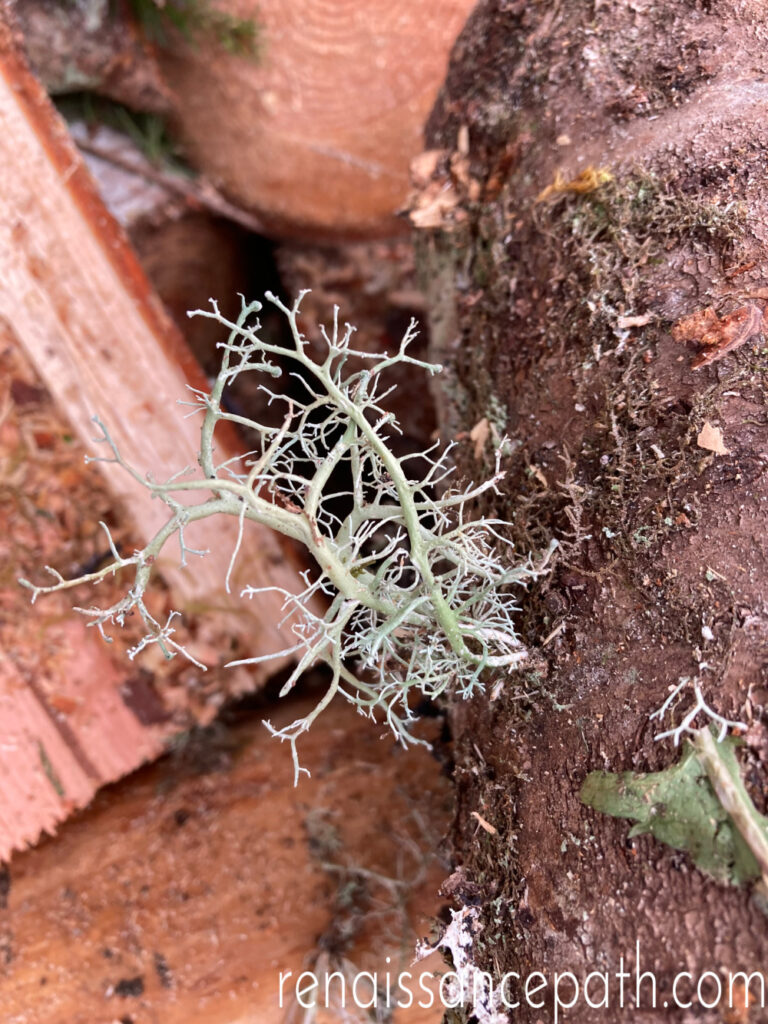
Usnea Uses
Usnea has been used in teas, tinctures, toothpaste, deodorants, and even sunscreens.
Some people use usnea as a natural dye.
Usnea’s main constituent is Usnic Acid which is used as a preservative in many products because of its microbial properties.
Usnea is used in herbal medicine to treat fungal, viral, and bacterial infections.
How to Process
Usnea needs to be broken down in order to access its wonderful healing properties.
You need to break down the cell walls in order to make it more bioavailable. Many herbs require more vigorous methods of extracting. Usnea happens to be one of them. It’s recommended that when processing usnea to make herbal medicine usnea needs to be chopped or cut into small pieces and sometimes ground with a pestle. Creating more surface area for the alcohol and water to pull the healing properties out is necessary.
Dual Extraction Usnea Tincture-Making the tincture takes a few more steps than most other herbal tinctures. Because usnea contains wonderful immune-stimulating polysaccharides they are best extracted by using heat and water.
I like to use Stephen Buhners method listed below
The tincture ratio should be 1:5(1 part herb to 5 parts liquid). Of the liquid, it should be made of half water and half grain alcohol.
For example, you have 5 ounces of herb, you’ll need 25 ounces of liquid-12.5 ounces of water, 12.5 ounces of alcohol.
To begin the process you would take the finely chopped usnea and put it into a crockpot with the water on the lowest heat setting for 48 hours with the lid on. I do recommend checking on it to make sure it doesn’t need more water because sometimes different crockpots can run hotter than others. You can even turn the crockpot off at night if you’re worried and maybe just add extra time to the extraction process.
Once the 48 hours is up you will transfer the usnea to a heat-safe jar like a mason jar. Once the decoction has cooled a bit, it can still be warm just not hot. You can then add the alcohol. Put the lid on and shake the jar making sure the usnea, water, and alcohol mix. You will leave the tincture to sit for 2-4 weeks shake daily if you can remember. Put the jar in a dark cool place.
Strain at the 2-4 week mark and put into dark amber glass tincture bottles preferrably. Although you can put it into a regular old glass mason jar. You just want to keep them out of the light. Store in a dark cool place.
Tincture dosage: 30-60 drops, up to 4x daily for acute infections
Wound powder-If you are want to make a wound powder you simply need to finely chop and ground usnea into a powder and sift out the white threads. You can apply the usnea powder to the wound and place a bandage over or you can add the powder to a herbal salve.
Contraindications, usnea should not be used internally while pregnant or breastfeeding. There have been reports of liver failure in some who have consumed large amounts of usnic acid the main compound of Usnea. Use with caution. Always ask a healthcare professional before starting a new supplement/herb or medication.
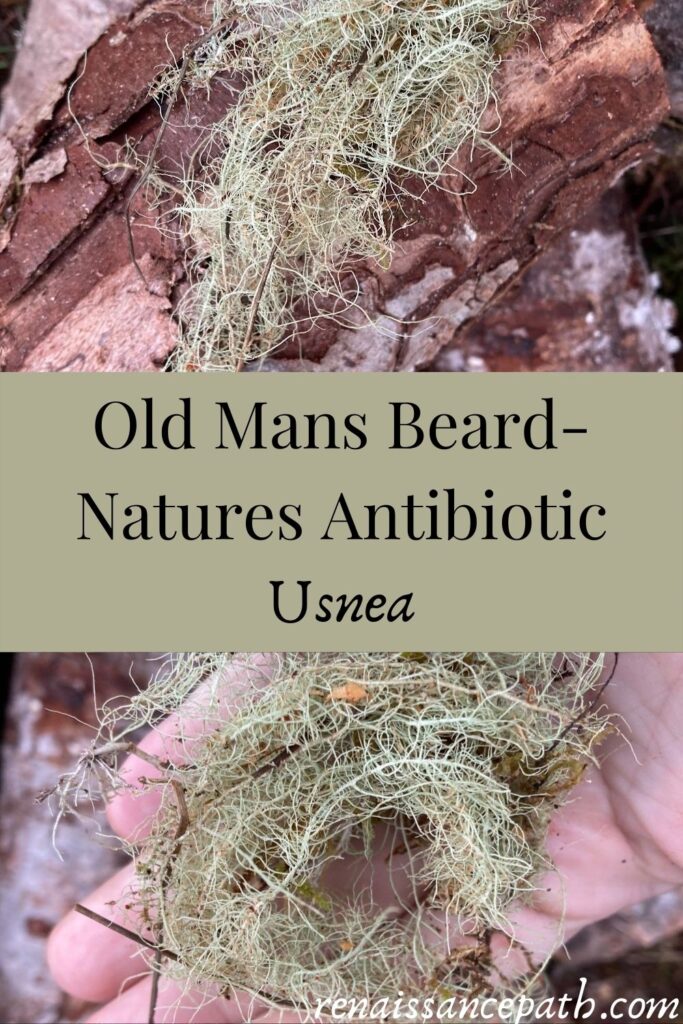
Where to Buy
If you can not forage for Usnea yourself you can purchase online.


Recap
Usnea is a powerful herbal ally. I like to think of it as natures antibiotic.
It is antifungal, antiviral and has anti-cancer properties.
When harvesting usnea you should only collect from fallen branches or trees.
When making a usnea tincture you should use the dual extraction method.
Have you ever harvested or used usnea? Let me know in the comments.
Much Love,
Melissa
If you love to make healing herbal medicine you should check out my recipe for Elderberry Syrup.
This website is for educational purposes only. The information provided by Renaissance Path is not intended to diagnose, treat, or cure any diseases. Please consult a qualified health care professional for medical advice.
I have collected some .About two cups worth.It has dried.can I still use?